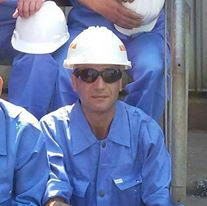Cams and followers , explanation and introduction
Cams and followers , explanation and introduction
A cam is a rotating or oscillating body which imparts reciprocating or oscillatory motion to a second body which is in contact with it.The second body is called a follower.
The most common types of cam are
1- the radial or plate cam,
2- the cylindrical cam
3- the face cam
 |
| FIG 1 |
Knife edge, flat-faced and roller followers are all used with plate and face cams. The knife edge type is only suitable for low speed applications where there is light contact force
The roller type is more wear resistant and is widely used in automated machinery. In automobile engines where the space is confined as shown in figure 2 (a) . the flat-faced follower is generally used, offset as shown in Figure 2 (b).
 |
| FIG 2 |
note : Dwell angle is the angle turned by a cam whilst the follower is stationary.
Cam profiles can be divided into two categories. Cams for which the cam profile is made up of circular arcs and tangents, as shown in Figure 2 and cams for which the required nature of the
follower motion determines the cam profile,
-- rise and fall with uniform velocity,
-- rise and fall with SHM
-- rise and fall with uniform acceleration and retardation.
The latter category are more expensive to produce and confined to special purpose applications.
Performance graphs showing the rise and fall of a knife-edged follower against angular position of the cam for these motions
are shown in Figure 3
 |
| FIG 3 |
Dwell periods have been omitted from the cams in Figure 3. and it will be noted that the cams have a characteristic heart shaped appearance. In certain applications, two or more of the different motions may be required together with dwell periods when the follower is at its extreme positions. Additionally, the cam may have a roller or flat-faced follower with offset. The projection construction process then becomes more complex and is beyond the range of this unit.
note There are two categories of cam. Those where the chosen shape determines the motion of the follower and those where the specified follower motion determines the shape of the cam.
Design of Cam Systems
The first stage in designing a cam system is the creation of a displacement diagram... A typical plate cam with an in-line roller follower is shown below figure 4 with a displacement diagram. This figure shows the following characteristic features.
1- The rise- This is when the follower is moving away from the cam centre. The slope reflects the follower velocity
2 - The dwell- the is the period when the follower is stationary
3- The return - This is when the follower moves back towards the cam centre
4- The base circle on the cam is the smallest full diameter of the cam
5- The prime circle is centered on the cam rotation centre with radius at the follower roller centre when the follower is on the base circle
6- The cam profile is the shaped surface of the cam defining the follower motion
 |
| FIG 4 |
The displacement diagram is a plot of the cam displacement vs the cam angle e.g. y = f(θ)
It is possible to plot additional graphs as follows
1) The First order Kinematic Relationship
f'(θ) = dy /dθ..
This is a plot of the slope of the displacement graph and thus the rate of movement of the follower. High values of f'(θ) result in very steep cam slopes with a risk the the follower will jam
2) The Second order Kinematic Relationship
f''(θ) = d²y /dθ²..
This is related to the curvature of the cam. If f''(θ) becomes very large the curvature of the cam approaches zero ( a point). This is highly unsatisfactory as it results in very high contact stresses and consequent wear...
3) The third order Kinematic Relationship
f'''(θ) = d³y /dθ³
Labels: MECHANICAL ENGINEERING





0 Comments:
Post a Comment
thanks for your visit
Subscribe to Post Comments [Atom]
<< Home